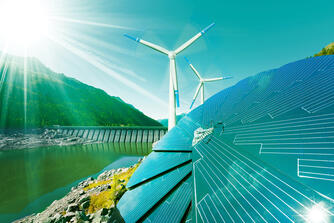Solution 3 - Direct reduction is optimization target
The DRI systems enable reduction with hydrogen

In the new DRI (direct reduced iron) route, green hydrogen is used to reduce iron ore pellets in the reactor. The sponge iron obtained is melted together with recycled scrap in the electric arc furnace to produce crude steel. The slabs, some of which are cast directly, are then rolled out in the hot rolling mill and, if necessary, further refined and the surfaces coated. This process produces around a tenth of the emissions of the blast furnace.
According to the example calculation for DRI production based on gas or coal in ISO 14404.3, the production of one ton of crude steel generates 1,455 kg of CO2.
By replacing coal and gas with green hydrogen, considerable amounts of CO2 can be saved.
This gives us reason to be confident that this technology will have a significant impact in the future.
How far has this new path been developed in Europe?
Replacing the blast furnaces and basic oxygen furnaces (BF-BOFs) of a traditional integrated steel plant with production based on direct reduced iron and electric arc furnaces (DRI-EAFs) is a mature technology option. High natural gas-based DRI-EAF production capacities are already in operation worldwide. There is also a variant in which the directly reduced iron (sponge iron) is melted in a smelter and processed into crude steel in a traditional oxygen steel plant. Various "green" test plants offer very good results and the first large-scale industrial DRI-EAFs, which replace BF-BOFs, have been ordered and will go into operation from 2026. CO2-emission savings of up to approx. 90% compared to the classic blast furnace route are estimated
The use of DRI as a raw material for steel production offers major advantages:
- Lower CO2-emissions: As no coking coal is required for DRI production, there are fewer CO2-emissions than with traditional blast furnace production.
- Flexibility: DRI can be used flexibly in steel production, whether in electric arc furnaces or as an additive in conventional blast furnaces to reduce the CO2-footprint.
- High degree of purity: DRI has a high degree of purity and contains few impurities, which is an advantage in steel production.
- Improved quality: The use of DRI can improve the quality of the final product in terms of strength and other mechanical properties.
- Resource consumption: As DRI is often produced from iron ore pellets, it can help to reduce the need for iron ore and thus conserve natural resources.